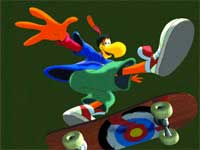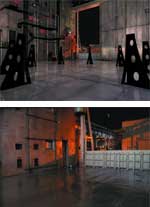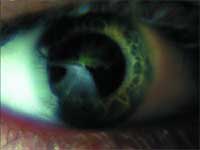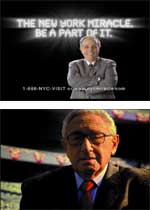 Everybody already knows, or should know, the ONE tip that all special effects houses have for getting the most brilliant work possible: call them early. This is such a universal thought that all those interviewed for this article said it without hesitation. However, this truism is but the tip of the iceberg. There's more to it than that, and the following scenarios give examples of how each special effects house solved particular challenges when creating effects for recent spot, music video or television series work. And, as always, Post catalogs what tools the artists are currently working with, as well as what they will be looking for at next month's NAB show.
Everybody already knows, or should know, the ONE tip that all special effects houses have for getting the most brilliant work possible: call them early. This is such a universal thought that all those interviewed for this article said it without hesitation. However, this truism is but the tip of the iceberg. There's more to it than that, and the following scenarios give examples of how each special effects house solved particular challenges when creating effects for recent spot, music video or television series work. And, as always, Post catalogs what tools the artists are currently working with, as well as what they will be looking for at next month's NAB show.
Special Effects House: The Orphanage (www.theorphanage.com), San Francisco Bay Area
Project: Bubba Sparxx music video Lovely for Partizan Entertainment
Challenge and Solution: Two days before shooting the music video, the client called from Atlanta. Could The Orphanage visual effects artists re-create a Jeep spot effect that showed a vehicle shaking off mud like a dog? The video producers wanted a 4x4 to splatter mud on a record executive. The Orphanage had less than 10 days to turn it around.
A quick conference call explained what the client needed to do on set technically. Director Chris Robinson was given explicit instructions so he could deliver the proper plates. In-house, CG artist Kevin Baillie modeled the truck, painted it, texture mapped it, animated it and then comped it into the shot that was about :04 long. He used Alias|Wavefront Maya V.x4 on a Power Mac G4 dual 800 MHz with 1 GB RAM and a nVidia GeForce 2MX dual 1.7 GHz Pentium 3 Xeon with 2 GB RAM and an nVidia Fire GL4.
"We actually overdelivered," explains executive producer John Benson. "We were so concerned with such a short turnaround, the only part we thought we'd be able to complete was the car shaking and having the mud fly off, and not actually have it settle in and be completely clean. But Kevin decided to take it beyond what we had promised, so he delivered the full shot of the car starting to shake, the mud flying off of it until it was completely clean and settled in to a still car. The cut used it all… They were very happy that they got more than what they were actually anticipating."
The Orphanage was founded in 1999 by three former ILM visual effects artists, part of that ICM's Rebel Mac group that discarded its SGIs in favor of Macs. That philosophy still holds at The Orphanage, which offers production, post and proprietary technology called Magic Bullet (shoot DV and make it look like film). The Orphanage is beta testing to get Maya fully up and running on Mac. Its visual effects work - everything but character animation - is used in features, television, spots and music videos.
 TIP: The Orphanage sticks to the Rebel Mac philosophy of "one artist, one shot." "All of our artist are generalists," says Benson. "We have some who are a little bit stronger in one thing than another, but it's very important for us to have artists who can take a shot, bring it online, model it, animate it, comp it in and handle all the traditional TD lighting," says Benson. "From a client perspective 'one artist/one shot' actually saves time, which translates into saving money. Because one of the biggest constraints in commercials and music videos is time, it's very important we're able to do as much as we can given whatever the constraints are."
TIP: The Orphanage sticks to the Rebel Mac philosophy of "one artist, one shot." "All of our artist are generalists," says Benson. "We have some who are a little bit stronger in one thing than another, but it's very important for us to have artists who can take a shot, bring it online, model it, animate it, comp it in and handle all the traditional TD lighting," says Benson. "From a client perspective 'one artist/one shot' actually saves time, which translates into saving money. Because one of the biggest constraints in commercials and music videos is time, it's very important we're able to do as much as we can given whatever the constraints are."
Truism: "Whenever possible, the greatest outcome is going to happen when we're brought in at as early a stage as possible," says Benson. "If clients wait very long they get stuck at a position where they might not have the same options available to them if they would have approached the visual effects company earlier on in the process. If they bring someone who technically knows what's available and what could happen, then I think they're going to squeeze more out for their budget. With agencies and commercials we love to get on board even before they've selected a director."
NAB Shopping List: The tech team will be looking at 1) the status of new rendering solutions, specifically those with support for Maya and Global Illumination (e.g.Brazil r/s, the software it is using for Path to War, an HBO original production scheduled to air by early summer); 2) the progress of realtime solutions for editing, compositing and color correction; Quantel's iQ, da Vinci, Piranha and Discreet among others; 3) Electric Image Universe with new rendering support for Global Illumination and Mac OSX; 4) updates to 24p HD and SD cameras by Sony, Panasonic and others; 5) the progress of Adobe's support for Mac OSX.
Special Effects House: A52 (www.a52.com), West Hollywood
Project: Nissan Altima Side Effects :30 spot for TBWA/Chiat/Day, Go Film and director Radish (Austrians Christoph Chrudimak and Mortiz Friedel)
Challenge and Solution: The agency challenged the directors to capture the car moving in a visually unique way. The result was a car as viewed by a camera on a bungee cord. The challenge for the A52 team, headed by visual effects supervisor and Discreet Inferno artist Simon Brewster, was to do the impossible: find some way to use a virtually unusable shot of very violent movement, clean it up and track it with the car.
 An Arriflex 435, shooting 35mm at 100 fps, had been rigged in a cage that was suspended from a 95-foot crane with a trigger release that caused it to fly up from the road. That shot was used in reverse. One problem was, at the top, the bungee cord bunched in front of the lens as the camera flew all over the place. "Everyone was into the idea but no one thought the shot was even usable," says Darcy Parsons, who co-directed with Leighton Greer for A52. Liz Roewe was the executive producer. "We had to work in CG to rebuild the backgrounds. It was several days work. However, Simon came up with some solutions that were insightful. He's pretty resourceful. He masterminded the shot."
An Arriflex 435, shooting 35mm at 100 fps, had been rigged in a cage that was suspended from a 95-foot crane with a trigger release that caused it to fly up from the road. That shot was used in reverse. One problem was, at the top, the bungee cord bunched in front of the lens as the camera flew all over the place. "Everyone was into the idea but no one thought the shot was even usable," says Darcy Parsons, who co-directed with Leighton Greer for A52. Liz Roewe was the executive producer. "We had to work in CG to rebuild the backgrounds. It was several days work. However, Simon came up with some solutions that were insightful. He's pretty resourceful. He masterminded the shot."
Brewster locked the car into the center of the frame, re-timed it and stabilized it before exporting the frames to visual effects artist Westley Sarokin, who put the car into its correct environment in Adobe Photoshop. Sarokin then sequenced it all up again in Discreet Flame and sent it to Mark Loso for more clean-up and finessing. Then it was lined up with its final live action plates in Inferno where it was color corrected. Brewster also had work to do in support shots -- several had speed rails and rigs around the car that had to be removed.
This spot is one of the 10 for the Nissan "cure for the common car" campaign; A52 provided visual effects shots for nine of them. The visual effects and broadcast design house's reputation is in providing cutting edge technical effects that are seamless and realistic, so much so that clients often have to be convinced how much work went into the shots. Willing to unveil a few secrets, A52's new demo reel will feature before and after shots.
TIP: Find the artists who are actually thrilled to be handed ridiculously difficult problems. "Our artists see the impossible and the idea of trying to solve it is pretty exciting," says Parsons.
Truism: "We like to get involved with directors in the beginning of the bidding process. If there are tricky problems to solve, we'll sit together with more than one Inferno artist. Several good minds can solve anything," says Parsons.
NAB Shopping List: "It's an interesting year, of course, and we always are interested in what Discreet is showing, like updates and the Combustion 2 software. We will also be looking at Sony's new compositing tools, as well as some other NT-based platforms. We are exploring a lot of different areas, including 24p capabilities," says Rick Hassen, A52 managing director. It will also be looking at Quantel's iQ.
Special Effects House: Liberty Livewire's Encore Video (www.encorevideo.com), Los Angeles
Project: Special effects on JAG, the one-hour series on CBS
Challenge and Solution: "JAG's been a high-def show since two years ago," says Kent Feeler, the senior compositor who works in Inferno to create the show's effects, which range from five to 10 minutes per episode. "Originally it was in NTSC then it went to HD 30fps and that changed to 24fps. It's definitely a challenging show to work on. The show's been on the air for seven years and a lot of the effects are repeated or slightly changed so we'll get elements on Beta SP, 1080i and 24p. All these formats have to be mixed and the end result is they have to be in 24p."
 "The newer Inferno software allows you to do that fairly easily; we're running 4.1 and upgrading to the upcoming 5. Version 4.1 is helping out quite a bit because it does have enough of a hard drive and processors to go through HD at a reasonsble speed, which is a little bit better than film because the file sizes are pretty close. Having done a lot of film work, I know how slow that is, and these sessions are client supervised, so they expect to see stuff at a pretty rapid pace. Inferno's about the only way you can do that. The average is two to two and a half hours for putting together a full scene, and if there's rotoscoping involved, we've got other people in the company to do that."
"The newer Inferno software allows you to do that fairly easily; we're running 4.1 and upgrading to the upcoming 5. Version 4.1 is helping out quite a bit because it does have enough of a hard drive and processors to go through HD at a reasonsble speed, which is a little bit better than film because the file sizes are pretty close. Having done a lot of film work, I know how slow that is, and these sessions are client supervised, so they expect to see stuff at a pretty rapid pace. Inferno's about the only way you can do that. The average is two to two and a half hours for putting together a full scene, and if there's rotoscoping involved, we've got other people in the company to do that."
An episode that aired in January needed a scenario with a submarine, a crew leaving and the wives waving. The sub shot came from the show's stock footage library. It was Beta SP/NTSC that was upres'd to HD 24p and combined with the greenscreen wives waving, shot HD. Feeler then created the sky, the water, all in all a digital collage of a brand-new scene. He spends one or two days a week on JAG - the other days are spent on Roswell and Ally McBeal.
The visual effects department at Encore Video has five Infernos, one Fire and three Macs. Encore is part of the Liberty Livewire Picture Group that includes eight other post facilities, including five others in the LA area: Hollywood Digital, Level 3 Post, Riot Santa Monica, Digital Symphony and POP Sound.
TIP: Offer clients the possibility of 3D solutions. "Right now the blend between 2D and 3D is becoming more blurred," reports Feeler. "3D is capable of doing some amazing things as well as compositing, so a lot of times the client doesn't really know that this is a much better 3D shot than a 2D shot until they walk in. The people here really try to prepare the client in terms of that," says Feeler. "For example, on Ally McBeal we had a scenario where Calista Flockhart's jaw drops and a truck drives into her mouth. That would obviously be a 3D shot and the 3D department delivered it complete without any 2D compositing involved. That was entirely done and finished in 3D, which is happening more than it used to. You used to just get 3D elements that would go into the Inferno, you would then composite it - the 3D guys now are doing their own compositing." The trade-offs is time [a 3D shot can take three days versus three hours].
Truism: "The more we know before a session - what they're trying to do, what elements they have - would help us quite a bit in terms of even bidding the process out or preparing for it," says Feeler.
NAB Shopping List: Smaller system/platforms that require less electricity or desktop space than an Onyx2. "That's what I'm going to be looking for in terms of what new software's out there, what are their capabilities, is this something a junior compositor might start on or is it something we can use for the work we do?" asks Feeler.
"I also want to see where Discreet is headed because that's the platform that I make a living on. Are they changing to a smaller platform? Maybe running on NT? I know they've come out with Combustion 2, which people say is good, but it's obviously not a system you could do a show like JAG on, which runs through 12 shots a day in HD, because the processing speed of HD files is very slow. And that is something that I think clients are having to get used to - that HD is a slower medium to work in even with the high-end, fastest boxes you can get. Is there a system out there that could do that?"
 Special Effects House: Quiet Man (www.quietman.net), New York City
Special Effects House: Quiet Man (www.quietman.net), New York City
Project: "New York Miracle" PSA, six :30s for BBDO and the City of New York
Challenge and Solution: Celebrity New Yorkers in landmark New York locations, trying to jump-start the city's beleaguered tourism industry. Each had a fun idea. Each was technically challenging. All were PSAs, which meant budgets didn't exist and time had to be found. They are airing nationally, at the discretion of the networks.
One spot features Woody Allen ice skating at Rockefeller Center. Of course it's a stunt double and Woody's head had to be tracked onto it. Johnnie Semerad, Quiet Man's Inferno artist/owner, also had to seamlessly transition the action to Woody's speaking line: "First time ever on skates!" Joe Pytka shot 35mm; his company produced.
Another PSA features NBC Today weatherman Al Roker running in the NYC Marathon, passing a tiny Ethiopian runner to win. Made to look like the live event, Pytka shot greenscreen footage of Roker on a treadmill, though actually it's a stunt double since Roker had just had knee surgery. Again, Semerad had to track Roker's head onto the footage. Both PSAs were done in Inferno.
"Turnaround time was really tight. And it was a PSA, so altogether we donated 750 hours of work. The Al spot had to be done before Christmas to run on New Year's because [soon to be former mayor] Rudy Guiliani was at the end of all of them," says Semerad. "We've done PSAs in the past, but never on this scale. We're doing one for Drug Free America right now which is like 50 hours, which is a normal job. We were booked, that's Super Bowl time - we were working on the Britney Spears/Pepsi spots, two Visa spots and a Dodge spot. We did the PSAs on weekends and late nights."
He adds, "We go 'hot bunk,' which means as soon as I get up, the seat's still warm and somebody else sits down in it. It's a military term about sharing your bed - it's still warm when the next guy gets in."
Quiet Man has five Discreet stations - Infernos, Flames and Flints - for visual effects and compositing work. It uses Softimage|XSI for animation and has a Mac-based design department. "For years we were known as an effects company but now our animation department is winning awards, our design department is winning awards," says Semerad.
TIP: When time is tight, work with people who speak the same shorthand. "The thing about this job, it was BBDO, Joe Pytka and Sherri and Clay [Margolies and Hemmert of Crew Cuts] 'cut em, so that was like getting the band back together. We've done a lot of work, the Britney stuff was done with the same team. We've been together a long time," says Semerad.
Truism: "The more you can talk ahead of time, the less pain in the end," says Semerad.
NAB Shopping List: "We've gone in the past," explains Semerad. "Right now it's a very strange time in the business because a lot of people are under the impression that we're going to flip a switch and go back to the way it was. I'm under the impression that it's going to be a gradual return, so right now we've been beefing
up the design department and the Softimage|XSI. We could go for another Flame now but we're kind of hesitant to spend that kind of money. I think there's going to be some used Flames out there. We're putting more emphasis on Mac/After Effects/Photoshop. On the whole Mac department combined, we probably haven't spent as much as one Inferno."